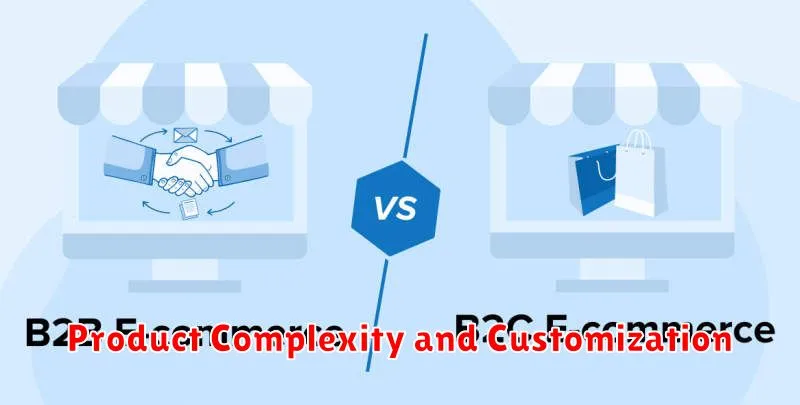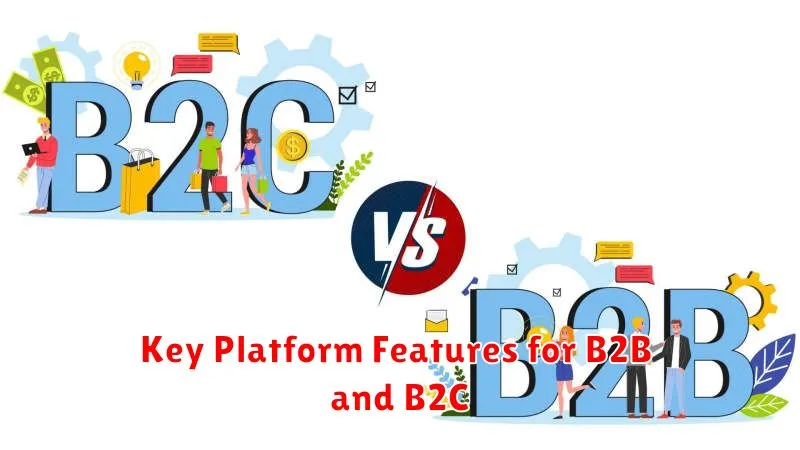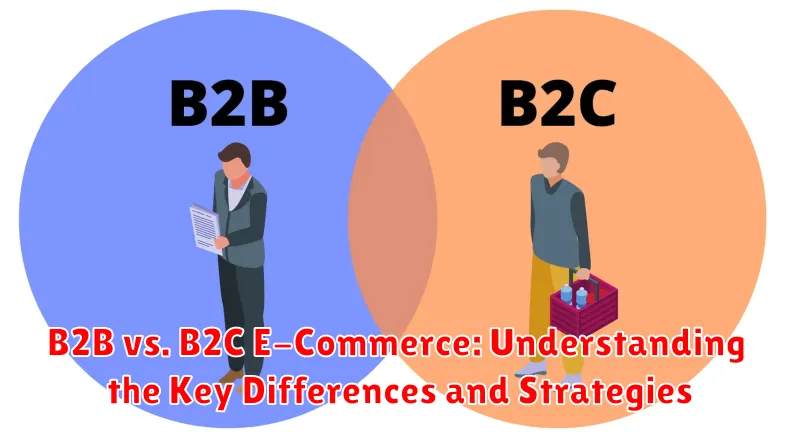Navigating the world of e-commerce requires a keen understanding of the distinct landscapes within it. One of the most fundamental distinctions lies in the target audience: business-to-business (B2B) e-commerce versus business-to-consumer (B2C) e-commerce. While both involve selling products or services online, they differ significantly in their sales processes, marketing strategies, and overall customer relationships. Understanding these key differences is crucial for businesses seeking to establish a successful online presence and maximize their return on investment (ROI). This article will delve into the core distinctions between B2B and B2C e-commerce, providing valuable insights into the unique challenges and opportunities presented by each model.
Whether you’re a seasoned entrepreneur or just starting out, grasping the nuances of B2B vs. B2C is paramount. From the complexity of the sales cycle to the nature of customer interactions, these two models demand different approaches. By exploring the core characteristics that differentiate B2B e-commerce from B2C e-commerce, businesses can tailor their strategies, optimize their platforms, and ultimately achieve greater success in their respective markets. This article will serve as a comprehensive guide, highlighting the key differentiators in pricing strategies, content marketing, and customer relationship management (CRM), empowering businesses to make informed decisions and thrive in the competitive world of online commerce.
Defining B2B and B2C E-Commerce
Business-to-business (B2B) e-commerce refers to online transactions between businesses. This could involve a manufacturer selling to a wholesaler, or a wholesaler selling to a retailer. B2B transactions often involve larger order volumes, longer-term contracts, and more complex pricing structures.
Business-to-consumer (B2C) e-commerce, on the other hand, involves transactions between businesses and individual consumers. This is the type of e-commerce most people are familiar with, encompassing online retail shopping, digital content purchases, and online service bookings. B2C transactions typically involve smaller order values, shorter sales cycles, and simpler checkout processes.
Target Audience: Businesses vs. Consumers
The most fundamental difference between B2B and B2C e-commerce lies in the target audience. B2B e-commerce platforms cater to the needs of businesses, focusing on sales to other companies. These businesses purchase products or services to use in their own operations, for resale, or to create new products.
In contrast, B2C e-commerce targets individual consumers who purchase goods or services for personal use. These purchases are often driven by individual needs and wants, rather than business requirements.
This core distinction influences all other aspects of the e-commerce experience, from website design and marketing strategies to pricing and customer service.
Sales Cycles and Order Values
A key differentiator between B2B and B2C e-commerce lies in their respective sales cycles and order values. B2B transactions typically involve longer, more complex sales cycles. These often include multiple decision-makers, negotiations, and a thorough evaluation process. Consequently, B2B sales cycles can extend from weeks to months.
In contrast, B2C sales cycles are generally much shorter. Consumers often make purchase decisions quickly, driven by immediate needs or impulses. This results in shorter sales cycles, often completed within a single browsing session.
Order values also differ significantly. B2B orders tend to be larger and involve higher values due to bulk purchases, ongoing contracts, and the nature of business procurement. B2C orders, on the other hand, typically involve smaller individual purchases with lower overall values.
Marketing Strategies for B2B and B2C
B2B marketing often focuses on building relationships, fostering trust, and demonstrating value through content marketing, webinars, and industry events. Content marketing plays a crucial role in educating potential clients and establishing thought leadership. Direct sales and account-based marketing are also common strategies.
B2C marketing, on the other hand, leverages emotional appeals and focuses on driving immediate purchases. Social media marketing, influencer collaborations, and paid advertising campaigns are frequently utilized. Promoting special offers and discounts are key tactics for attracting consumers and encouraging sales.
Product Complexity and Customization

B2B products often involve greater complexity and customization than B2C products. B2B transactions frequently involve highly specialized or technical goods tailored to specific industry requirements. Customization options, such as configuring specific features or integrating with existing systems, are common.
B2C products, on the other hand, tend to be more standardized and less complex. While some level of personalization might be offered (e.g., selecting a color or size), the core product remains largely the same for all consumers. Customization is generally limited, focusing on aesthetic choices rather than functional modifications.
This difference in complexity and customization impacts various aspects of e-commerce, including product information requirements, sales processes, and post-sale support. B2B platforms require detailed technical specifications and often involve consultation with sales engineers. B2C platforms prioritize visual appeal and user-friendly product descriptions.
Content Marketing Approaches in B2B vs. B2C
Content marketing strategies differ significantly between B2B and B2C e-commerce. B2C content often focuses on generating immediate sales through engaging, emotionally driven content like lifestyle articles, product demos, and user-generated reviews. The goal is to capture consumer attention and encourage quick purchasing decisions.
In contrast, B2B content marketing prioritizes building long-term relationships and establishing credibility. Content like white papers, case studies, webinars, and in-depth blog posts offer valuable information that helps businesses make informed decisions. The sales cycle is typically longer and involves multiple stakeholders, requiring content that addresses complex needs and demonstrates expertise.
The table below summarizes the key differences:
| Feature | B2C | B2B |
|---|---|---|
| Goal | Drive immediate sales | Build relationships, establish credibility |
| Content Type | Product demos, user reviews, lifestyle articles | White papers, case studies, webinars |
| Focus | Emotional appeal, short-form content | Logical reasoning, data-driven content |
Customer Relationship Management (CRM) in B2B and B2C
CRM takes distinct forms in B2B and B2C environments. B2C CRM often focuses on automating marketing and sales processes, personalizing customer interactions, and improving customer service efficiency. Data collection centers around purchase history, demographics, and online behavior to segment customers for targeted campaigns and personalized recommendations.
In contrast, B2B CRM emphasizes managing complex, long-term relationships. Sales cycles are longer, involving multiple decision-makers and requiring personalized communication and relationship building. Data gathered includes company profiles, industry information, and individual contact roles within the organization. This allows for targeted account-based marketing and a deeper understanding of client needs. B2B CRM often integrates with other business systems like ERP and marketing automation platforms to provide a holistic view of the customer journey.
Pricing Strategies and Negotiation
Pricing strategies differ significantly between B2B and B2C e-commerce. B2C typically involves fixed pricing displayed publicly, with occasional discounts or promotions. B2B pricing is often more complex, involving tiered pricing based on volume, negotiated contracts, and customized quotes.
Negotiation plays a larger role in B2B transactions. Relationships are cultivated, and pricing discussions are common. B2C rarely involves negotiation, with the price generally being non-negotiable.
B2B businesses may offer volume discounts, early payment discounts, and other incentives to encourage larger orders and faster payment. These are less common in the B2C world.
Price transparency is another key difference. B2C pricing is generally transparent and readily available. B2B pricing may be less transparent, requiring customers to contact sales representatives or request a quote.
Key Platform Features for B2B and B2C

B2B e-commerce platforms often require features that cater to complex purchasing processes. These include robust quote management systems, detailed product catalogs with specifications and variations, and account management tools for tiered pricing and order tracking. Integration with existing enterprise resource planning (ERP) systems is also crucial for streamlined operations.
B2C platforms prioritize ease of use and a seamless customer journey. Key features include intuitive search and navigation, personalized product recommendations, diverse payment gateway integrations, and user-friendly checkout processes. Social media integration and customer review features are also highly valuable in influencing purchasing decisions.
| Feature | B2B | B2C |
|---|---|---|
| Catalog Management | Detailed specs, variations | Simplified product information |
| Pricing | Tiered, negotiated | Fixed, transparent |
| Checkout | Account-based, purchase orders | Guest checkout, quick purchase |

